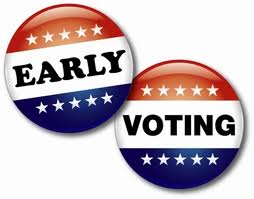Texas Monthly crunches some numbers from Day One:
Digging further into the numbers, it seems as though the long-whispered awakening of Texas Democrats happened, at the very least, on day one. GOP consultant Derek Ryan, who published a detailed report on the affiliations of Texas’s early voters, examined the voting history of Monday’s voters, and what he found was notable. Of the votes cast, 36.8 percent of them were from people who had previously voted in the Republican primary, while 32.8 percent of them had voted in the Democratic primary. The rest were split between people who had previously voted in general presidential elections but not party primaries (22.3 percent) and those with no election history whatsoever (8.1 percent).
We don’t know how those voters with history in party primaries are inclined to vote in the general election, but the mere fact that the numbers for Republicans and Democrats are only four points away from one another is significant in and of itself. As our own Erica Greider pointed out on Twitter Tuesday afternoon, Republican primary voters outnumbered Democratic primary voters by a whopping 2:1 margin. So on day one of early voting, a whole lot more of the Democrats who voted in the primaries felt the need to rush to the polls than the Republicans did.
There are other things we can glean from the early voting totals. The gender split here is vast: At least 54 percent of voters on Monday were women, while men made up 42.2 percent of the day’s electorate (the other 3.8 percent are unknown). That could be tricky for Trump, as Nate Silver’s imagined women-only electoral map analysis pointed out—Trump’s biggest base of support comes from men, and if men aren’t casting ballots at the same rate as women, he may have a lot of ground to make up.
And ultimately, all of this analysis is moot if the turnout numbers level off by the end of the week. It’s possible that we’re mostly going to see the same people vote in 2016 as we did in 2012. If that’s the case, the 8.1 percent of voters who haven’t previously cast general election ballots will be notable, but probably not significant enough to tilt the election.
Couple things here. First, the thing to keep in mind about the voters with no primary history is basically what Greider says. There have been a lot more Republican primary voters in recent elections than Democratic primary voters, so the pool of non-primary voters is proportionally more Democratic than the voting population overall since you’ve subtracted so many more Republicans from it. One of the harbingers of doom for Democrats in 2010 during early voting was exactly this – a large portion of these voters had not voted in the 2008 primary, which in Harris County at least meant they almost had to be non-Democrats, since the Dem primary turnout had been so large that year. These non-primary voters aren’t certain the be Dems, but they are more likely to be Dems than a random sample of all voters would be.
Having said that, many of those 2008 Dem primary voters still exist in the population, so this inference only goes so far. That analysis by Derek Ryan only specifies “previous R/D primary voters”; it does not specify “in one or more of the past 3 elections”, which would limit the scope to post-2008 primaries. It’s common to limit this sort of thing to the last three elections, but it’s not universal – the data exists in any database a guy like this would be using. I just don’t know for sure what Ryan has in mind.
For what it’s worth, I’ve seen an analysis of the in-person Harris County Day One vote that said 31% of voters had voted in at least one of the last three Republican primaries (that is, 2012, 2014, and 2015), with 32% having done the same in at least one Dem primary. That was in person only, so about half the total vote so far. Further analysis of the whole data set using other metrics suggests the Dems have a pretty decent lead at this time, which is unusual in that it’s usually the Rs who get out more on Day One and via mail. But this is only one day, and things do change over time. There’s a lot of early voting to go, and a lot of votes to be cast. I’ll definitely be keeping an eye on this.
Here are a couple of maps of where early voters came from for Day One and mail ballots. Here’s the Day Two EV report, which as you can see shows an increase in turnout from Monday: 73,542 people showed up Tuesday, an increase of a bit more than 6,000 from Monday. Add in another 2,834 mail ballots, and a grand total of 205,390 people have already voted in Harris County. (Including me – I voted at the SPJST Lodge for the first time. I’ve now voted in six different EV locations. Maybe I should try to collect them all.) I don’t know what the partisan mix looks like yet, but you can see the updated spreadsheet and make your own guesses. Have you voted yet?


I’ve managed to vote at eight different locations in Harris County in the past 15 years (and a ninth for a school bond, non-general election with a strange rotating early voting location setup), though two probably shouldn’t count since they don’t do early voting there any more. I can only remember voting on election day four times, and two were unadvertised snap elections by school boards. I’ve done my research and now just need to find a convenient time to go that’s hopefully not everyone else’s convenient time.